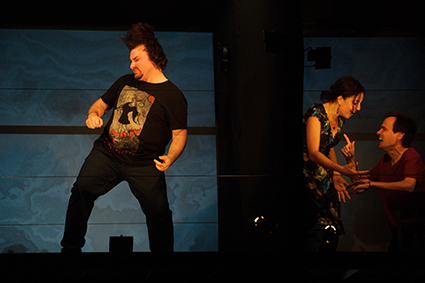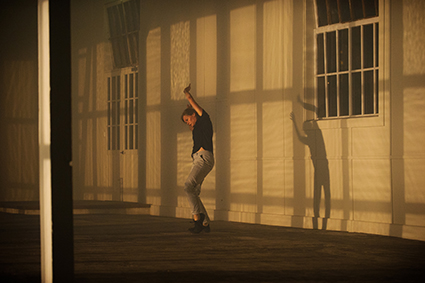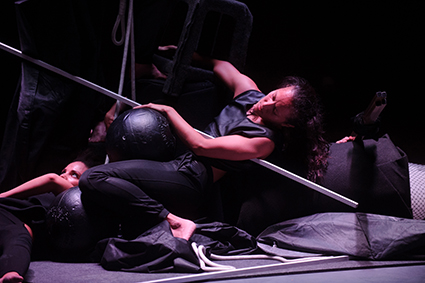At play with perception & consciousness
Philipa Rothfield

Rawcus Ensemble, Catalogue, Dance Massive, Arts House
photo Sarah Walker
Rawcus Ensemble, Catalogue, Dance Massive, Arts House
According to Immanuel Kant, we can only experience the world through the lens of space and time. Prue Lang’s Spaceproject puts this idea to work in relation to movement and its perception. A companion piece, Timeproject (shown in France, 2013), took up the same thought in relation to time.
Prue Lang, Spaceproject
Lang’s exploration is human-centred rather than merely objective. It also acknowledges the centrality of the body within all perceptual experience. For example, the dancers imaginatively make their way into the bush. Their perceptions of the local landscape and its flora and fauna are completely corporeal: spider webs get caught in their hands and fingers, they look up at a vast sky, and shelter from the rain by curling their bodies around one another under a table.
It is not that our perception of space is merely subjective. Our experience of objective space is mediated by a body which simultaneously feels. The question becomes how the two aspects, subjective and objective, cleave together. Lang deals with these issues in movement. The dancers walk in a series of floor patterns. They must negotiate their own bodies, via feeling (or proprioception) and visual cues. Add to that, the citation of compass-style directions and you have this interplay between subjective and objective space.
Lang plays between representations of space (eg imaginative trips to the bush) and existentially based spatial games that call for here and now movement decision making. To what extent can the imaginary offer insights into lived space? What does the difference between the actual and the virtual tell us about space? The work combines a range of ways into thinking about, or rather, dancing space. It also attempts to deal with ideas, perhaps too many, certainly too many for this particular piece. It feels like this work is the first draft of a more subtle, better thought through work which is more settled in the bodies of its dancers. This is, I think, more a question of time than of space.
Rawcus, Catalogue
Rawcus’ Catalogue is also human in scale. It tackles normative presumptions surrounding the human, recalibrating the scale towards a celebration of difference. The performance space is divided into cubes, cosy stages for one or more. Right from the get go, the performers assert their right to interpret popular culture in their own way, through sound and movement. The cult of celebrity is drawn upon by way of displacement (or strategic redeployment) rather than critique. Individual performers reinterpret popular songs through their bodies, celebrating their own singularity rather than resenting, or even referring to, the privileged place of the other. In that sense, Catalogue is pure affirmation. It doesn’t shy away from questions of loss or bereavement or illness but gives an everyday gloss to these elements, neither repudiating them nor denying their impact. So, we learn about these performers, who is ill, who lives with their parents, who is married and so on. I’m not sure whether this is a celebration of the ordinary or a way of finding beauty within it, like the plastic bags blowing in the wind in Sam Mendes’ film, American Beauty (1999). Catalogue finishes with an entire set of different faces, gesturing towards a new sense of the human beyond the specificity of the Rawcus crew.

Rosalind Crisp, Boom Project, Dance Massive
photo Sarah Walker
Rosalind Crisp, Boom Project, Dance Massive
Rosalind Crisp, The Boom Project
Rosalind Crisp has a very distinctive way of improvising. It is as if she turns to her body as a source of movement material, to be played out for an observational consciousness (Crisp herself). This consciousness has no idea what will emerge but it is the viewer, the first audience for her dancing. So there is a naivety or freshness in Crisp, a beginner’s mind with respect to the dance. Her face is open, agnostic, unknowing. She looks at the audience, surprised that we are here. It is not that she is lost, rather she is absorbed in the ongoing corporeal revelations found in the dance. It is the dancing which leads her and not vice-versa. This manner of witnessing is enhanced in The Boom Project by the inclusion of a second witness and sometime dancer (Helen Herbertson). Together, that part of Crisp which watches and does not know and Herbertson who mostly watches, make space for new movement to arise. An unfamiliar space enhances this sense of unfolding serendipity. The large warehouse, a woodworking atelier, does not have a history of performance. The building is itself witness to something new. Designer Ben Cobham insinuates white, clear, cold light, in shafts, lines, creating spillage from another room. It’s delicate, like lace, the dance as lacemaking.
Shelley Lasica, Solos for Other People
It’s odd to think of a group work in solo terms but there is something about Shelley Lasica’s Solos for Other People that draws the gaze towards the singular dancer. This is in part because the choreography refers to Lasica’s own body. Even when others dance her material, it more or less looks like her. Some of these dancers have worked with Lasica for years. It shows. The dancing merges with who they are. Perhaps who they are is partly the result of working in this way.
So there is a strand of sameness or identity running throughout. And yet, after watching 10 people dance simultaneously, differences start to emerge; performative differences, in timing, attack, investment in the material, in the relation between the material and one’s own body. Clearly, nothing is guaranteed in the transmission of work from body to body. A body has to adapt itself to the material or the material adapts itself to the body. We see both.
The vastness of the space (a basketball court) means that one gaze cannot take in all that happens. The viewer is forced to make choices and thereby make do with an incomplete perception. There is always more than can be seen. I am surprised when the dancers circle the space and run out the door, as if the work is surely not over. There is a sense that it has been going on for a long time and continues to do so.

Antony Hamilton, Melanie Lane, Ashley McLellan and Sophia Ndaba, Merge, Dance Massive, Arts House
photo Sarah Walker
Antony Hamilton, Melanie Lane, Ashley McLellan and Sophia Ndaba, Merge, Dance Massive, Arts House
Melanie Lane, Merge
Melanie Lane’s Merge is uncanny, inhuman, odd to say the least. Ostensibly about our relation to the object, it seems to me to be an attempt to displace our sense of the human. The dancers are bent over, occupied by invisible concerns, quibbling over the space. The space is made and remade, via unexpected turns and twists. A simple square of carpet becomes a wall, turns a corner and becomes a labyrinth. Bodies become otherwise in partial obscurity. We don’t always know where one begins and another finishes. There is a great deal of play in Merge, of engagement with its material elements and among its four dancers. Towards the end, a plethora of objects is introduced, towards a monumental potlatch of destruction. Is this anarchy, hiatus, catharsis, apocalypse? The objects fail to produce an intensification of the action. Is this their ultimate revenge?
Dance Massive: Spaceproject, concept, direction: Prue Lang, choreography Lang and dancers, Dancehouse, 10-13 March; Rawcus, Catalogue, co-director: Kate Sulan, Ingrid Voorendt, deviser-performers Rawcus ensemble, Meat Market, 10-14 March; The Boom Project, dancer, choreographer Rosalind Crisp, companion, provocateur: Helen Herbertson, Blueprint Showroom, 13-21 March; Solos for other People, choreographer, director Shelley Lasica; Merge, choreographer Melanie Lane, Arts House, 18-22
RealTime issue #126 April-May 2015 pg. 22






